Studying the Characteristics of Chaos and Fractals of Construction Rocks under Different Loading Velocities
Abstract
:Highlights
- Rock materials exhibit obvious strain rate effects at different loading velocities.
- The damage evolution process of rock materials contains chaotic features.
- Logical mapping is used to analyze rock material damage–strain information sequences.
- The fractal dimension of rock sample crack is positively correlated with load velocity.
Abstract
1. Introduction
2. SHPB Test
2.1. Sample Preparation
2.2. Experimental Setup and Test Method
3. Results
3.1. Stress–Strain Curves
3.2. The Sample Debris after Loading
4. Discussion
4.1. The Chaotic Characteristics of Rock Sample Damage Evolution
4.1.1. Rock Damage
4.1.2. Chaotic Characteristics
4.2. Effect of Loading Velocity on Chaotic Characteristics
4.3. The Fractal Characteristics of Rock Sample Damage Evolution
4.3.1. The Damage Fractal Dimension
4.3.2. The Variation of Fractal Dimension
5. Conclusions
- Construction rock exhibits significant strain rate effects under dynamic loading conditions. As the impact pressure increases from 0.05 to 0.23 MPa, the peak stress of the sample increases from 82.19 to 284.16 MPa (an increase of 245.74%), and the increase process is in accordance with the power function law; the average particle size of the sample debris is reduced from 46.57 to 18.34 mm (reduced by 60.62%).
- The damage–strain evolution information of the construction rock shows chaotic characteristics. The increase in the load velocity can delay the evolution of the generalized damage variable into the bifurcation state and the chaotic state.
- The damage–strain evolution law (trend) of the sample from the initial moment of damage to the start of the period of bifurcation at different loading pressures shows similarity, and the slope of the fitted straight line is less than 7%.
- Under dynamic loading conditions, the damage evolution process of the samples has fractal characteristics at the start of the bifurcation and chaotic periods, and the damage cracks have statistical self-similarity. Meanwhile, the increase in load velocity significantly increases the degree of homogenization of crack development in the process of damage.
Author Contributions
Funding
Data Availability Statement
Conflicts of Interest
References
- Li, D.X.; Wang, E.Y.; Kong, X.G.; Jia, H.S.; Wang, D.M.; Muhammad, A. Damage precursor of construction rocks under uniaxial cyclic loading tests analyzed by acoustic emission. Constr. Build. Mater. 2019, 206, 169–178. [Google Scholar]
- Gu, Q.H.; Ma, Q.; Tan, Y.L.; Jia, Z.C.; Zhao, Z.H.; Huang, D.M. Acoustic emission characteristics and damage model of cement mortar under uniaxial compression. Constr. Build. Mater. 2019, 213, 377–385. [Google Scholar] [CrossRef]
- Sirdesai, N.N.; Gupta, T.; Singh, T.N.; Ranjith, P.G. Studying the acoustic emission response of an Indian monumental sandstone under varying temperatures and strains. Constr. Build. Mater. 2018, 168, 346–361. [Google Scholar] [CrossRef]
- Sun, B.; Chen, R.; Ping, Y.; Zhu, Z.; Wu, N.; He, Y. Dynamic Response of Rock-like Materials Based on SHPB Pulse Waveform Characteristics. Materials 2022, 15, 210. [Google Scholar] [CrossRef]
- Sun, B.; Chen, R.; Ping, Y.; Zhu, Z.; Wu, N.; Shi, Z. Research on Dynamic Strength and Inertia Effect of Concrete Materials Based on Large-Diameter Split Hopkinson Pressure Bar Test. Materials 2022, 15, 2995. [Google Scholar] [CrossRef]
- Sun, B.; Chen, R.; Ping, Y.; Zhu, Z.; Wu, N. Study on Axial Tensile Strain Rate Effect on Concrete Based on Experimental Investigation and Numerical Simulation. Materials 2022, 15, 5164. [Google Scholar] [CrossRef]
- Hirata, T. Fractal structure of spatial distribution earthquake-The two point correlation function. Geophys. J. R. Astron. Soc. 1980, 62, 303–320. [Google Scholar]
- Chen, Y.F.; Lu, J.H.; Zhou, C.B. Predicition of slope displacement by using Lyapunov exponent improved technique. Chin. J. Rock Mech. Eng. 2001, 20, 671–675. (In Chinese) [Google Scholar]
- Wang, L.G.; Song, Y.; Miao, X.X. Lyapunov exponent of chaos feature in the processing of deformation failure for coal floor. Chin. J. Geotech. Eng. 2002, 24, 356–359. (In Chinese) [Google Scholar]
- Liu, D.Q. Study on Rock Damage Constitutive Model and Chaos Characteristics in the Process of Deformation and Failure. Ph.D. Thesis, China University of Mining and Technology, Beijing, China, 2014. [Google Scholar]
- Sun, H.; Liu, X.L.; Zhu, J.B. Correlational fractal characterisation of stress and acoustic emission during coal and rock failure under multilevel dynamic loading. Int. J. Rock Mech. Min. 2019, 117, 1–10. [Google Scholar] [CrossRef]
- ZZhu, F.; Wu, X.; Zhou, M.; Sabri, M.M.S.; Huang, J. Intelligent Design of Building Materials: Development of an AI-Based Method for Cement-Slag Concrete Design. Materials 2022, 15, 3833. [Google Scholar] [CrossRef] [PubMed]
- Geng, J.S.; Sun, Q.; Zhang, Y.C.; Cao, L.W.; Zhang, W.Q. Studying the dynamic damage failure of concrete based on acoustic emission. Constr. Build. Mater. 2017, 149, 9–16. [Google Scholar] [CrossRef]
- Wu, N.; Zhu, Z.D.; Zhu, C.; Luo, Z.H. Dynamic Behavior of Rock Joint Under Different Impact Loads. KSCE J. Civ. Eng. 2019, 23, 541–548. [Google Scholar] [CrossRef]
- Fakhimi, A.; Azhdari, P.; Kimberley, J. Physical and numerical evaluation of rock strength in Split Hopkinson Pressure Bar testing. Comput. Geotech. 2018, 102, 1–11. [Google Scholar] [CrossRef]
- Huang, S.; Chen, R.; Xia, K.W. Quantification of dynamic tensile parameters of rocks using a modified Kolsky tension bar apparatus. J. Rock Mech. Geotech. Eng. 2010, 20, 162–168. [Google Scholar] [CrossRef] [Green Version]
- Feng, P.; Dai, F.; Liu, Y.; Xu, N.; Fan, P. Effects of coupled static and dynamic strain rates on the mechanical behaviors of rock-like specimens containing preexisting fissures under uniaxial compression. Can. Geotech. J. 2018, 55, 640–652. [Google Scholar] [CrossRef] [Green Version]
- Mishra, S.; Chakraborty, T.; Matsagar, V.; Loukus, J.; Bekkala, B. High strain rate charactterization of deccan trap rocks using SHPB device. J. Mater. Civ. Eng. 2017, 30, 04018059. [Google Scholar] [CrossRef]
- Li, H.M.; Li, H.G.; Gao, B.B.; Jiang, D.J.; Feng, J.F. Study of acoustic emission and mechanical characteristics of coal samples under different loading rates. Shock. Vib. 2015, 2015, 458519. [Google Scholar] [CrossRef] [Green Version]
- Gong, F.Q.; Ye, H.; Luo, Y. The effect of high loading rate on the behaviour and mechanical properties of coal-rock combined body. Shock. Vib. 2018, 2018, 4374530. [Google Scholar] [CrossRef] [Green Version]
- Millon, O.; Ruiz-Ripoll, M.L.; Hoerth, T. Analysis of the Behavior of Sedimentary Rocks Under Impact Loading. Rock Mech. Rock Eng. 2016, 49, 4257–4272. [Google Scholar] [CrossRef]
- Xia, K.W.; Yao, W. Dynamic rock tests using split Hopkinson (Kolsky) bar system–A review. J. Rock Mech. Geotech. Eng. 2015, 7, 27–59. [Google Scholar] [CrossRef] [Green Version]
- Zhang, Q.B.; Zhao, J. A Review of Dynamic Experimental Techniques and Mechanical Behaviour of Rock Materials. Rock Mech. Rock Eng. 2014, 47, 1411–1478. [Google Scholar] [CrossRef] [Green Version]
- Wu, N.; Zhu, Z.D.; Zhou, Y.J.; Gao, S.H. A Comparative Study on Rock Properties in Split and Compression Dynamic Test. Shock. Vib. 2018, 2018, 2861537. [Google Scholar]
- Hokka, M.; Black, J.; Tkalich, D.; Fourmeau, M.; Kane, A.; Hoang, H.; Li, C.; Chen, W.W.; Kuokkala, V.T. Effects of strain rate and confining pressure on the compressive behavior of Kuru granite. Int. J. Impact Eng. 2016, 91, 183–193. [Google Scholar] [CrossRef]
- Lemaitre, J. A continuous damage mechanics model for ductile materials. J. Eng. Mater. Technol. 1985, 107, 83–89. [Google Scholar] [CrossRef]
- Gabriel, J.P.; Saucy, F.; Bersier, L.F. Paradoxes in the logistic equation. Ecol. Model. 2005, 185, 147–151. [Google Scholar] [CrossRef] [Green Version]
- Chen, Y.S. Studies on Damage Evolution Characteristics in Non-Interpenetrated Material under Axial Compressive Condition. Master’s Thesis, Xi’an University of Technology, Xi’an, China, 2002. [Google Scholar]
- Balka, R.; Buczolich, Z.; Elekes, M. A new fractal dimension: The topological Hausdorff dimension. Adv. Math. 2015, 274, 881–927. [Google Scholar] [CrossRef] [Green Version]
- Fernández-Martínez, M.; Sánchez-Granero, M.A. How to calculate the Hausdorff dimension using fractal structures. Appl. Math. Comput. 2015, 264, 116–131. [Google Scholar] [CrossRef]
- Croydon, D.A. The Hausdorff dimension of a class of random self-similar fractal trees. Adv. Appl. Probab. 2007, 39, 708–730. [Google Scholar] [CrossRef] [Green Version]
- Luo, Z.H.; Zhu, Z.D.; Ruan, H.N.; Shi, C. Extraction of microcracks in rock images based on heuristic graph searching and application. Comput. Geosci.-UK 2015, 85, 22–35. [Google Scholar] [CrossRef]
- Tavares, L.M. Chapter 1 Breakage of Single Particles: Quasi-Static. Handb. Powder Technol. 2007, 12, 3–68. [Google Scholar]
- Tavares, L.M.; King, R.P. Modeling of particle fracture by repeated impacts using continuum damage mechanics. Powder Technol. 2002, 123, 138–146. [Google Scholar] [CrossRef]
- King, R.P.; Bourgeois, F. Measurement of fracture energy during single-particle fracture. Miner. Eng. 1993, 6, 353–367. [Google Scholar] [CrossRef]
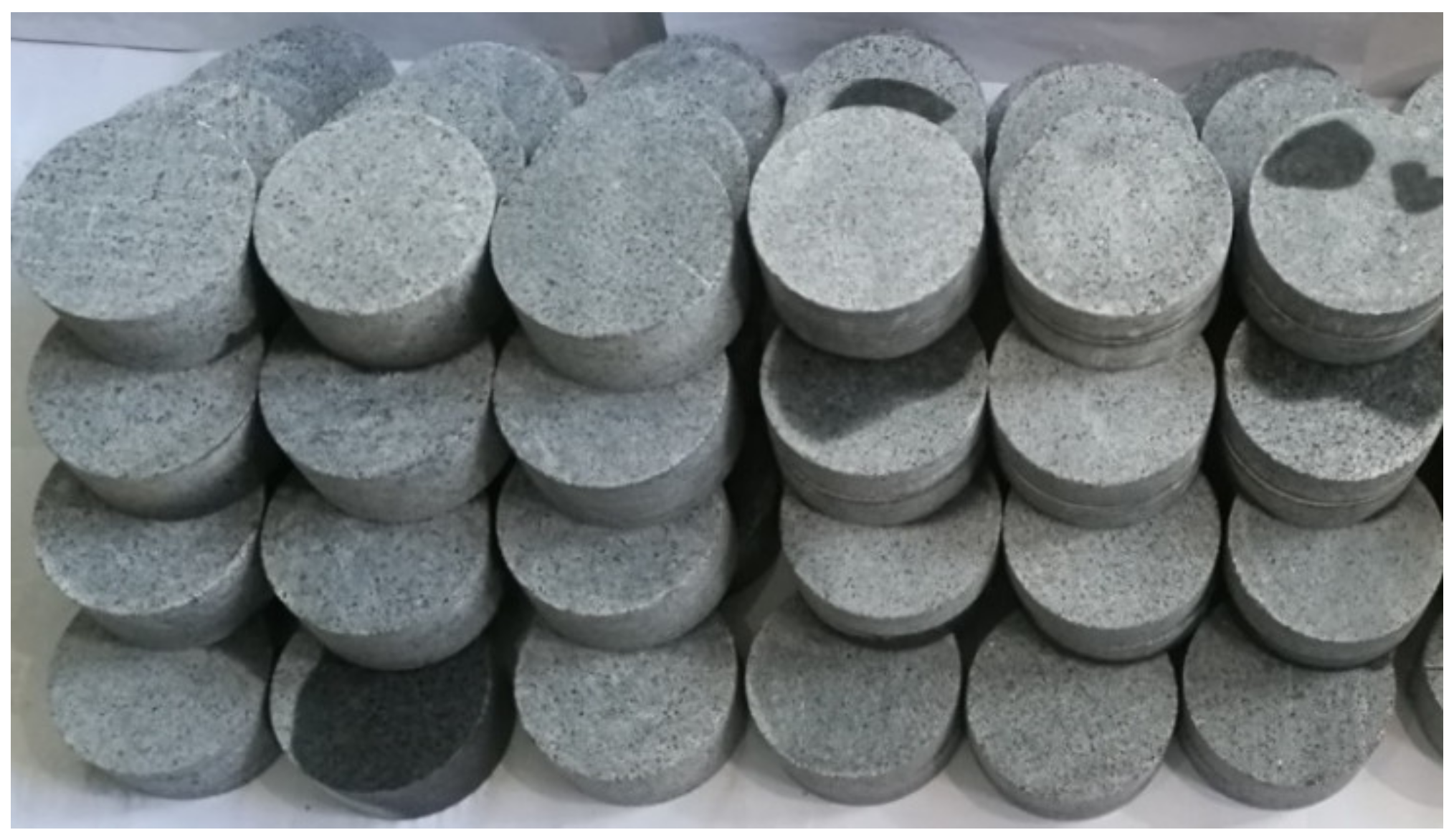


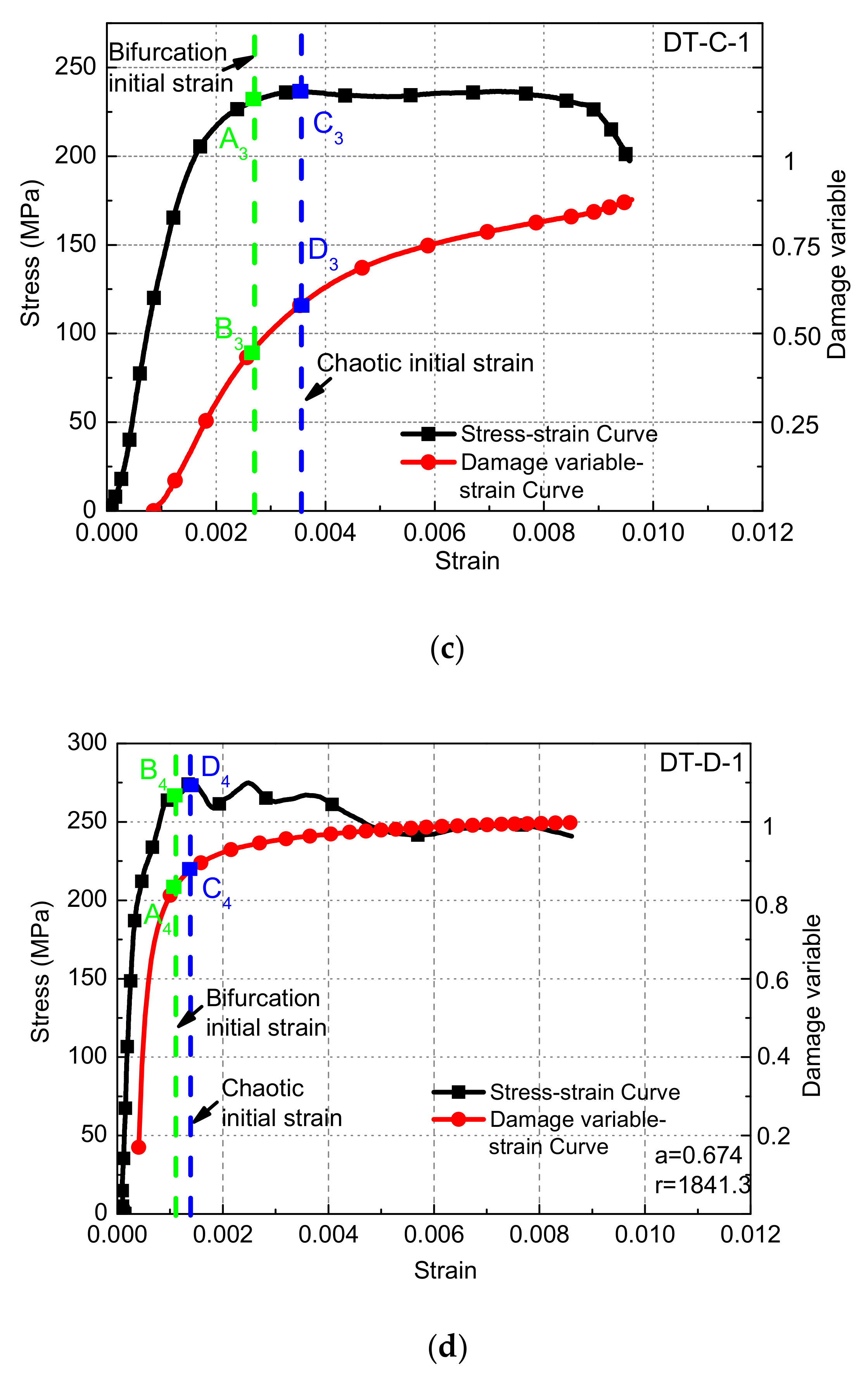
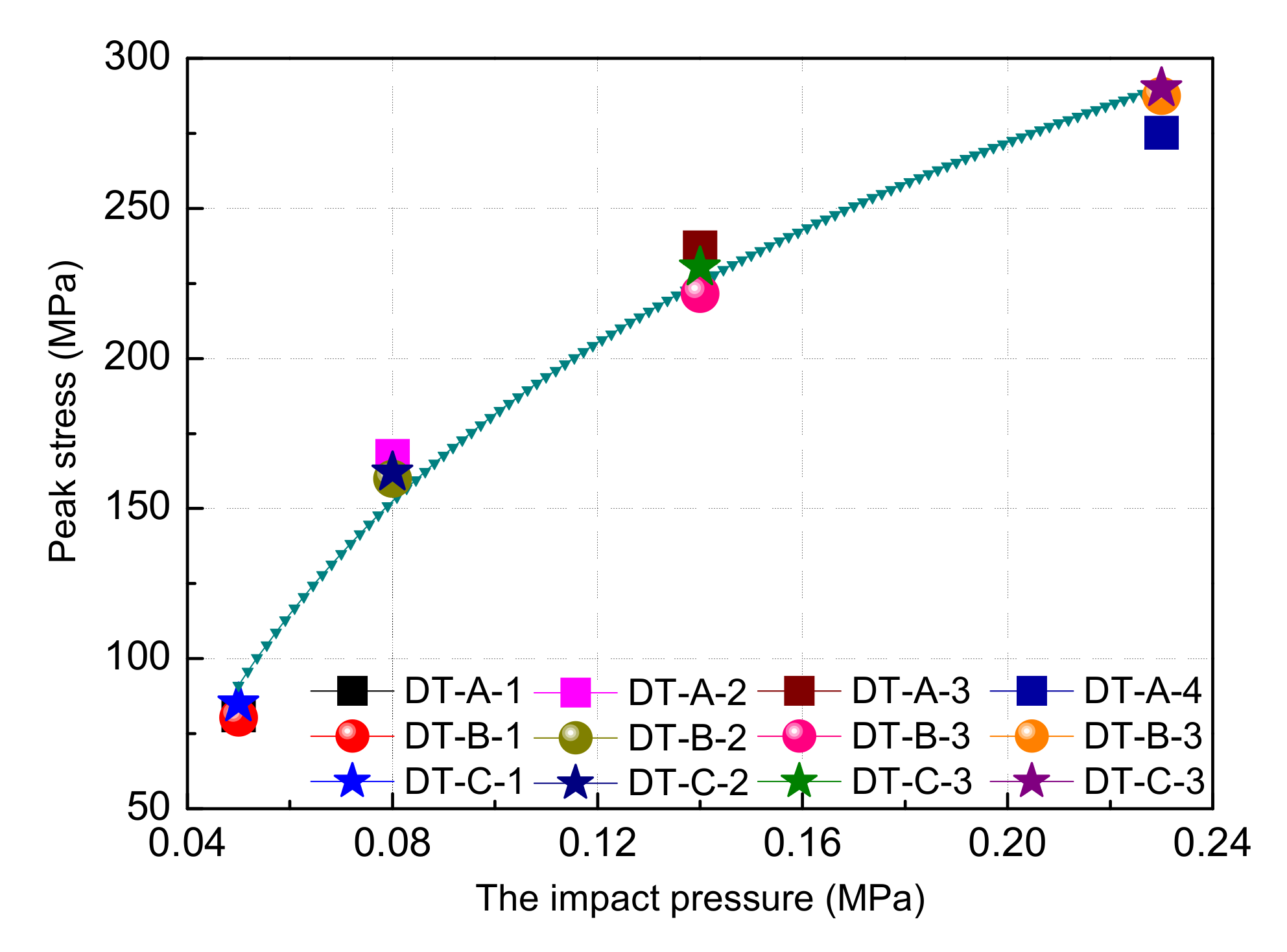
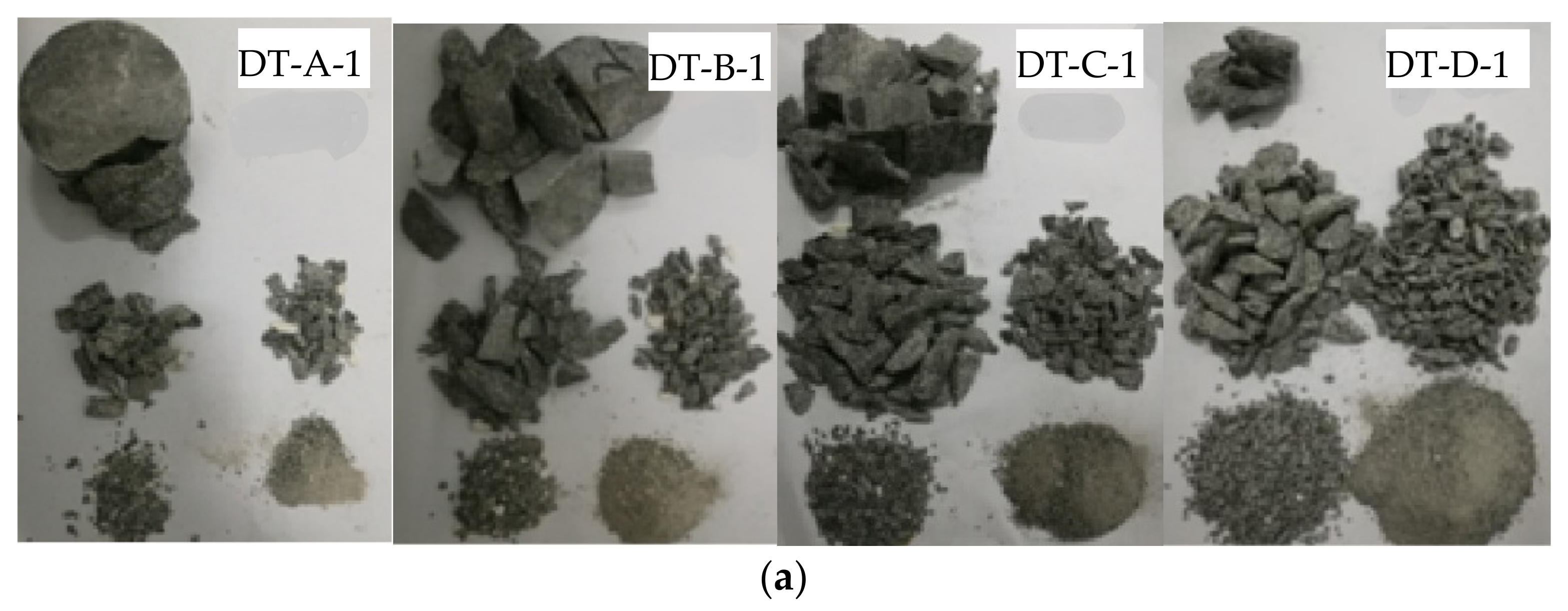
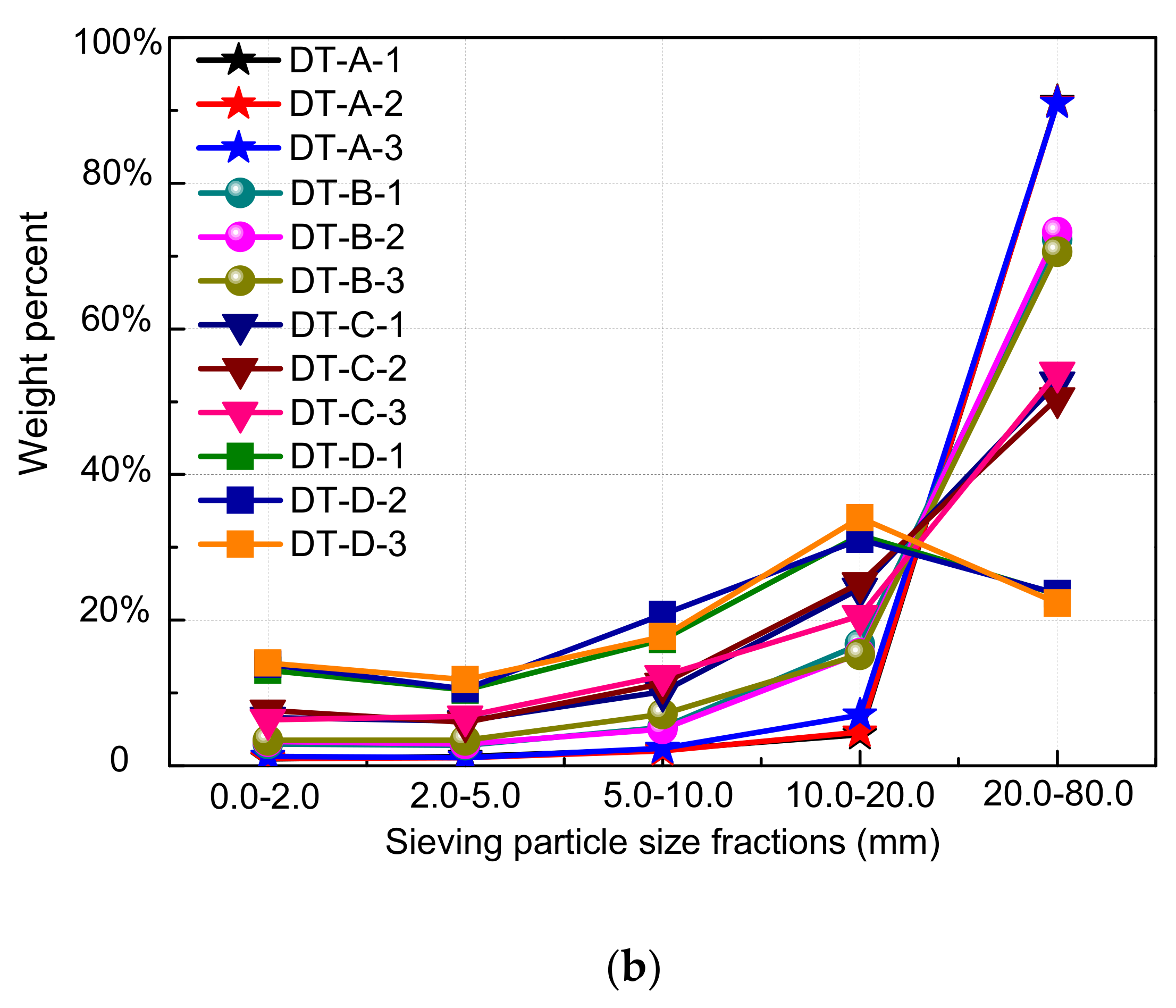
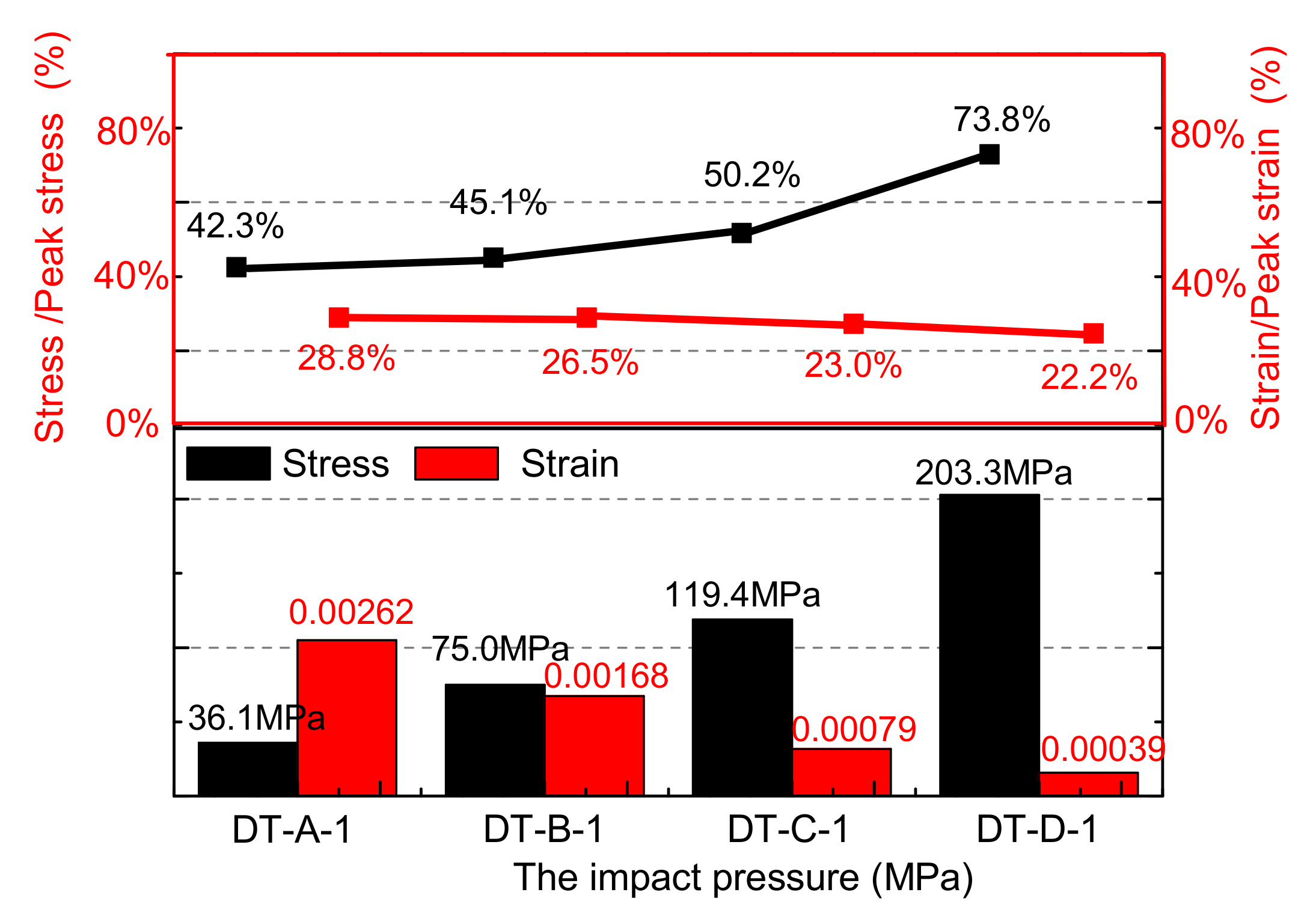
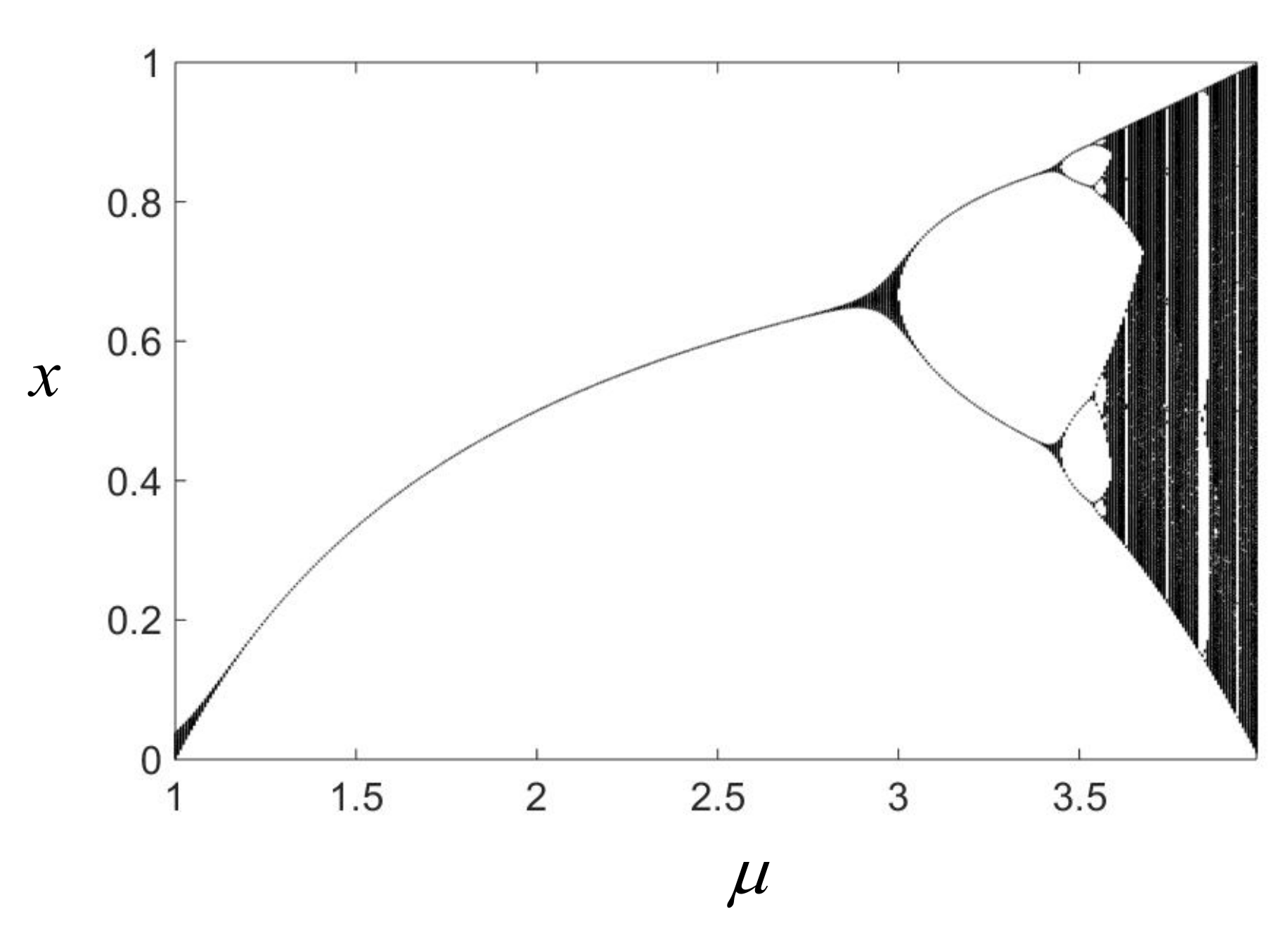
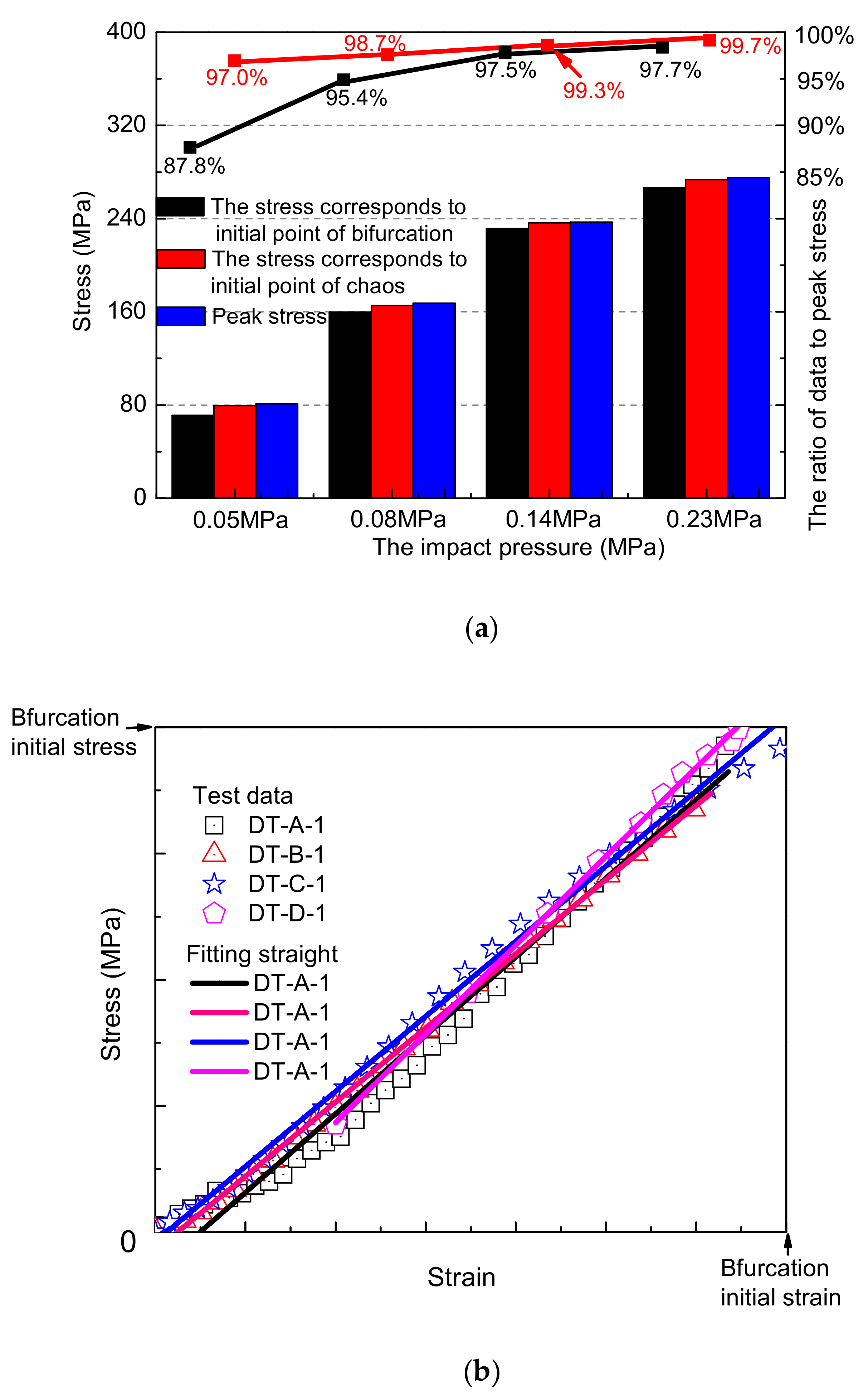
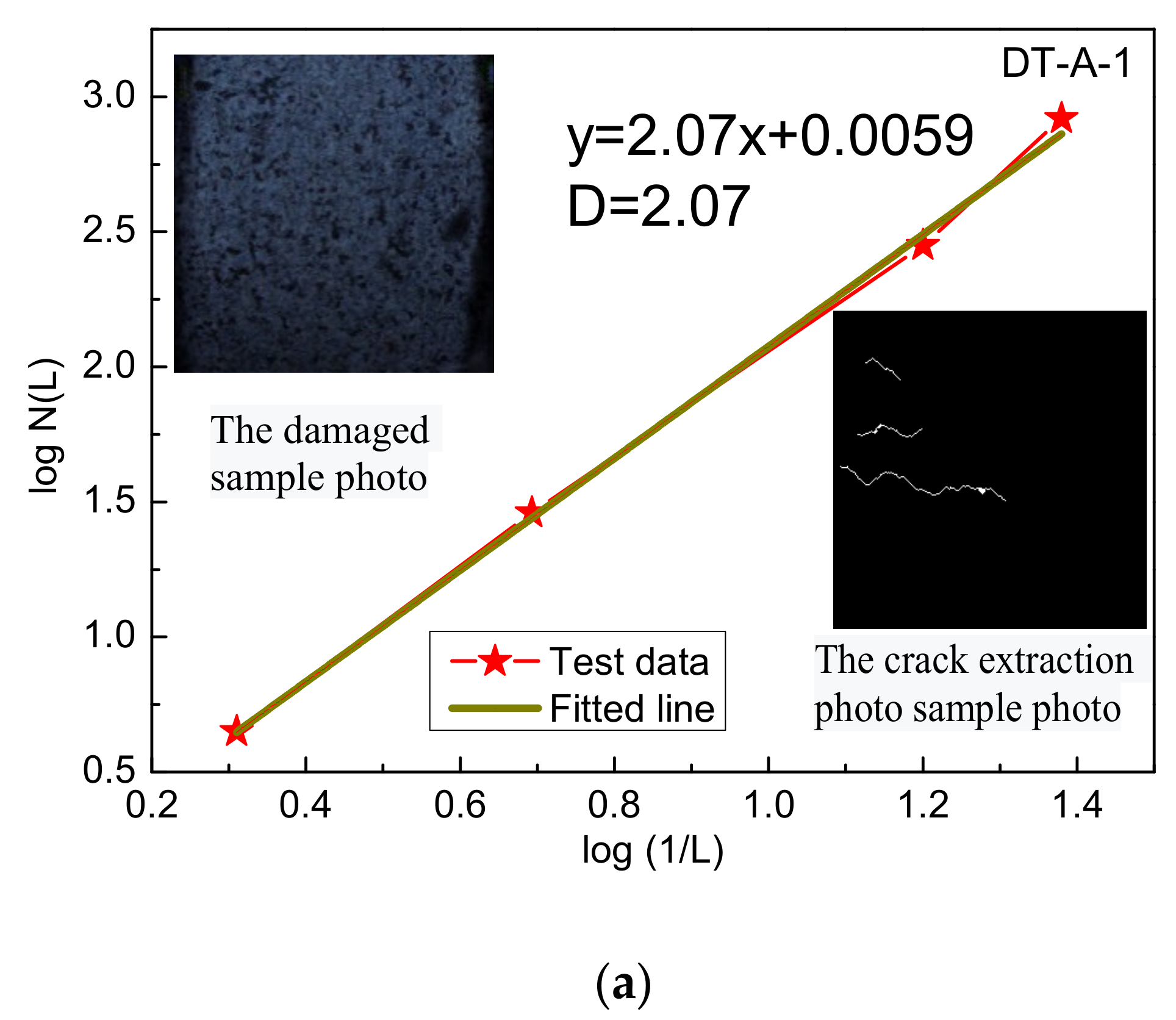
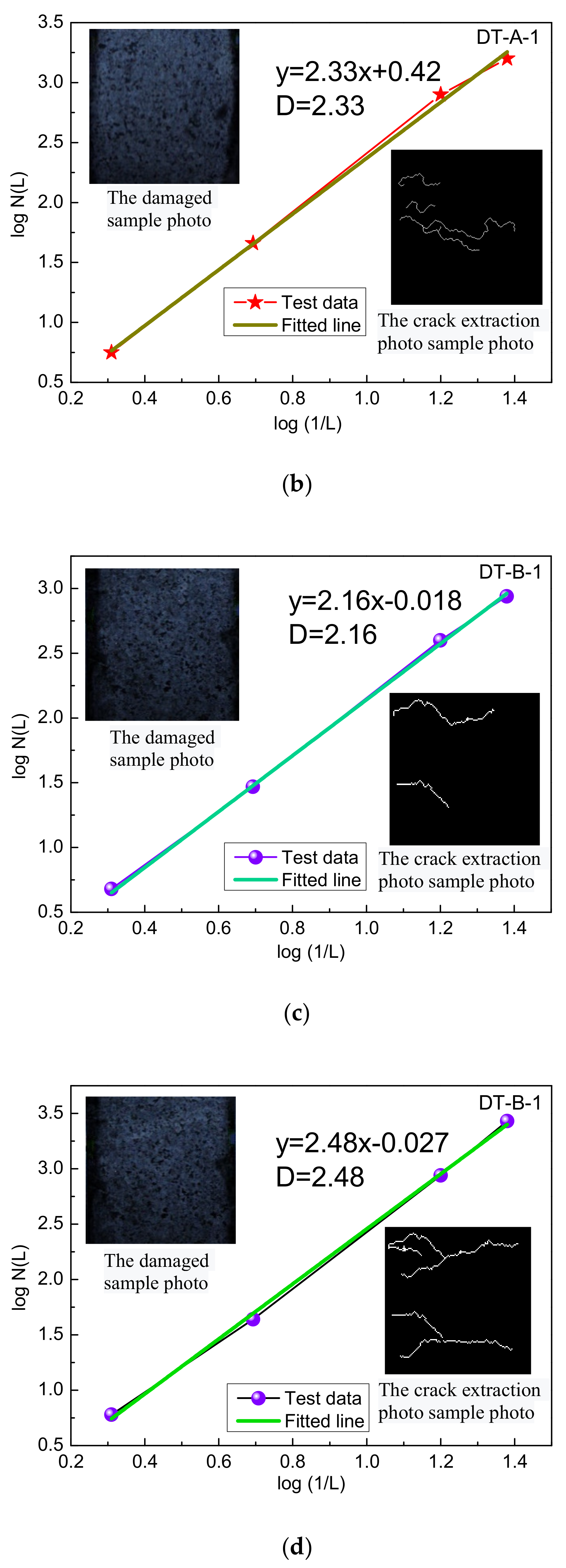
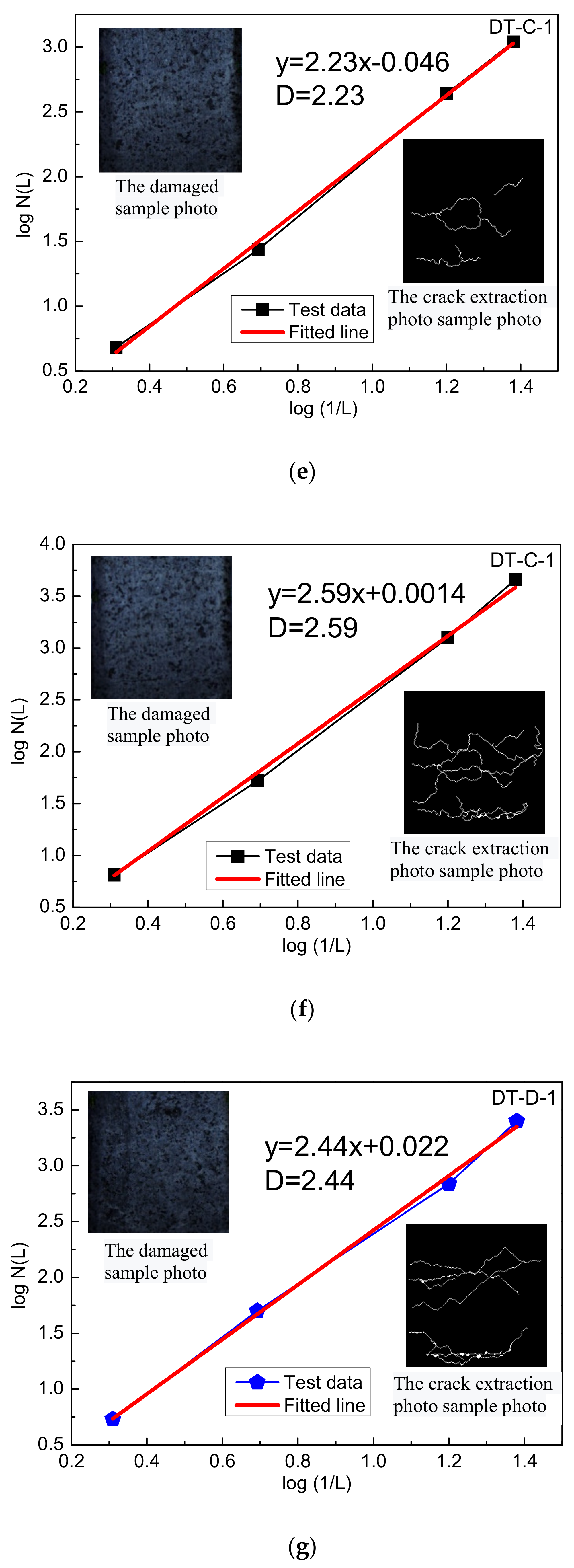
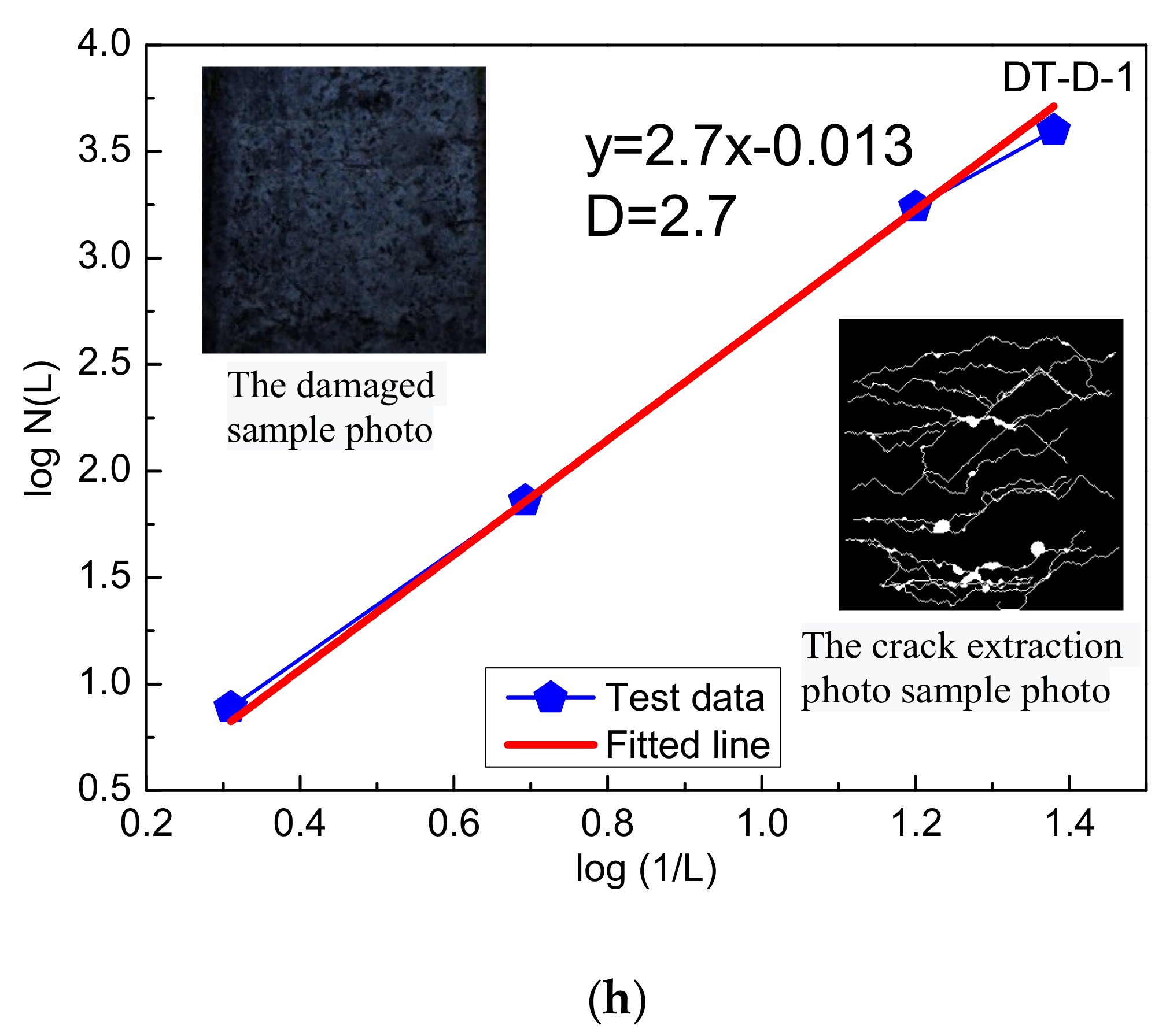

| Sample Number | Impact Pressure | Impact Velocity (m/s) | Peak Strength (MPa) | Stress Values Corresponding to Different Starting Times (MPa) | ||
|---|---|---|---|---|---|---|
| (MPa) | Damage | Period-Doubling Bifurcation | Chaotic | |||
| DT-A-1 | 0.05 | 3.52 | 81.10 | 36.1 | 71.2 | 79.4 |
| DT-A-2 | 0.05 | 3.42 | 80.31 | 32.3 | 67.5 | 77.4 |
| DT-A-3 | 0.05 | 3.46 | 85.17 | 37.6 | 73.3 | 82.3 |
| DT-B-1 | 0.08 | 6.65 | 167.51 | 72.0 | 159.8 | 165.4 |
| DT-B-2 | 0.08 | 6.91 | 159.91 | 78.3 | 145.7 | 155.7 |
| DT-B-3 | 0.08 | 6.67 | 162.11 | 75.7 | 163.8 | 159.9 |
| DT-C-1 | 0.14 | 9.71 | 237.02 | 119.4 | 231.7 | 236.3 |
| DT-C-2 | 0.14 | 9.77 | 221.52 | 123.1 | 227.5 | 225.7 |
| DT-C-3 | 0.14 | 9.90 | 230.33 | 117.9 | 237.9 | 227.8 |
| DT-D-1 | 0.23 | 3.61 | 275.10 | 203.3 | 266.6 | 273.4 |
| DT-D-2 | 0.23 | 3.67 | 287.38 | 207.9 | 273.7 | 284.9 |
| DT-D-3 | 0.23 | 3.55 | 289.99 | 200.3 | 269.9 | 288.1 |
| Sample Number | Impact Pressure (MPa) | mvi/% | m/g | Average Particle Diameter (mm) | ||||
|---|---|---|---|---|---|---|---|---|
| 1 | 2 | 3 | 4 | 5 | ||||
| DT-A-1 | 0.05 | 0.93% | 1.31% | 2.24% | 4.29% | 91.23% | 536 | 46.48 |
| DT-A-2 | 0.05 | 1.01% | 1.11% | 2.04% | 4.63% | 91.11% | 540 | 46.45 |
| DT-A-3 | 0.05 | 1.29% | 1.10% | 2.39% | 6.99% | 90.99% | 544 | 46.77 |
| DT-B-1 | 0.08 | 3.00% | 2.81% | 5.24% | 16.67% | 72.28% | 534 | 39.16 |
| DT-B-2 | 0.08 | 3.35% | 2.97% | 5.02% | 15.43% | 73.23% | 538 | 39.45 |
| DT-B-3 | 0.08 | 3.54% | 3.54% | 7.08% | 15.27% | 70.58% | 537 | 38.27 |
| DT-C-1 | 0.14 | 6.62% | 6.17% | 10.17% | 24.36% | 52.68% | 539 | 31.04 |
| DT-C-2 | 0.14 | 7.63% | 5.97% | 11.31% | 25.08% | 50.47% | 543 | 30.13 |
| DT-C-3 | 0.14 | 6.31% | 6.77% | 12.32% | 20.61% | 53.99% | 536 | 31.31 |
| DT-D-1 | 0.23 | 13.10% | 10.41% | 17.31% | 31.65% | 23.53% | 532 | 18.31 |
| DT-D-2 | 0.23 | 13.95% | 10.52% | 20.80% | 31.07% | 23.64% | 535 | 18.55 |
| DT-D-3 | 0.23 | 14.10% | 11.81% | 17.71% | 34.04% | 22.34% | 543 | 18.16 |
Publisher’s Note: MDPI stays neutral with regard to jurisdictional claims in published maps and institutional affiliations. |
© 2022 by the authors. Licensee MDPI, Basel, Switzerland. This article is an open access article distributed under the terms and conditions of the Creative Commons Attribution (CC BY) license (https://creativecommons.org/licenses/by/4.0/).
Share and Cite
Wu, N.; Fu, J.; Xiong, C. Studying the Characteristics of Chaos and Fractals of Construction Rocks under Different Loading Velocities. Materials 2022, 15, 7890. https://doi.org/10.3390/ma15227890
Wu N, Fu J, Xiong C. Studying the Characteristics of Chaos and Fractals of Construction Rocks under Different Loading Velocities. Materials. 2022; 15(22):7890. https://doi.org/10.3390/ma15227890
Chicago/Turabian StyleWu, Nan, Jiyang Fu, and Chao Xiong. 2022. "Studying the Characteristics of Chaos and Fractals of Construction Rocks under Different Loading Velocities" Materials 15, no. 22: 7890. https://doi.org/10.3390/ma15227890
APA StyleWu, N., Fu, J., & Xiong, C. (2022). Studying the Characteristics of Chaos and Fractals of Construction Rocks under Different Loading Velocities. Materials, 15(22), 7890. https://doi.org/10.3390/ma15227890







